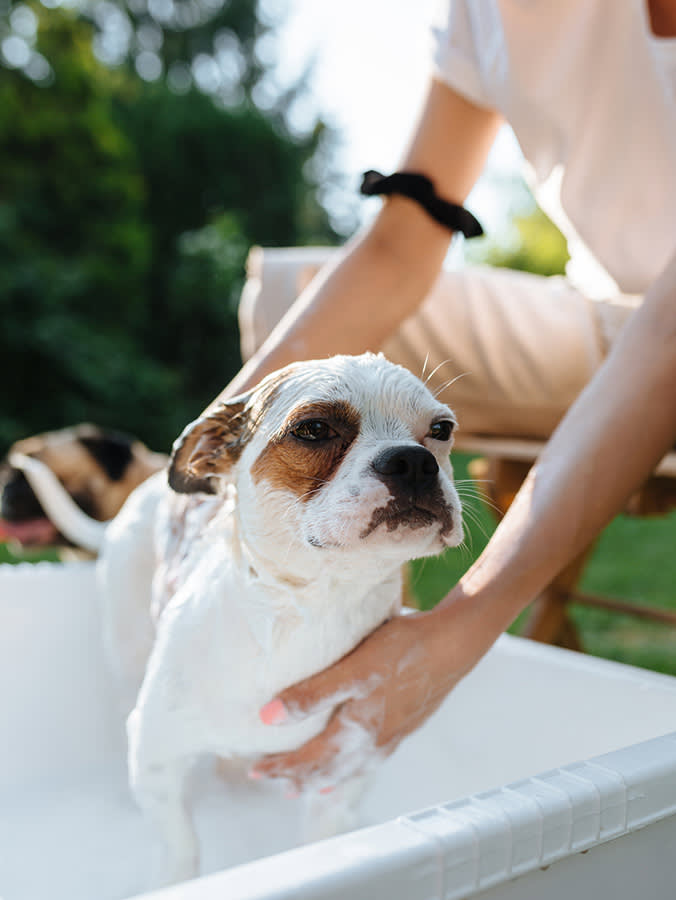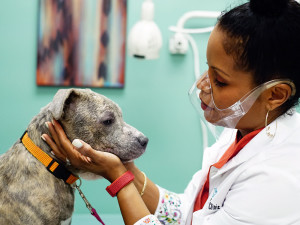How to Treat Dog Skin Diseases at Home
And how you might safely give your pup immediate relief.
If your dog is suffering from a skin disorder, you may have experienced the frustration and desperation of trying all kinds of different treatments just to give your pup a little relief. Skin conditions can be tricky to resolve, and sometimes it takes multiple vet visits and tests to get to the bottom of what is causing them. It’s important to emphasize that any dog with a skin condition should be examined by a veterinarian prior to starting a home remedy since many conditions require prescription treatment protocols. And while these home remedies may provide short-term relief from itchy or dry skin, none of these are cures.
Skin disease in dogs encompasses so many different conditions, and the tricky factor is that many skin diseases look similar to one another on the surface. A dog with itchy red skin could have an infection, allergies, fleas, or an underlying hormonal imbalance. Without a thorough examination and diagnostic tests with a veterinarian, it can be impossible to sort out what is going on and what treatment your dog needs to get their flowing fur and flawless skin back.
Snap a pic of your pup’s teeth, and GREENIES™ will help you spot potential signs of oral health issues.
Be sure to make your vet’s office the first stop in your treatment plan when you notice your pup has a new skin problem. If you’re waiting on test results or have to bide your time before the visit, there are some home treatments that can provide short-term relief to your pup and may be worth a try.
What are the common symptoms of skin conditions in dogs?
Like people, dogs can encounter a wide variety of skin conditions throughout their lives, and some of these are easy to cure, while others require a long-term management approach to a chronic condition. The list of possible skin conditions is extensive and ranges from common conditions to the very rare. In some cases, your veterinarian may recommend that you see a specialist in veterinary dermatology in order to do more advanced tests or get a specialist’s insights if you are not seeing improvement in your pup’s condition. For starters, here are some of the most common symptoms in dogs with skin conditions:
How much do you spend on your pet per year?
Dry skin
Dry skin is one of these catchall terms with many causes. Flaky skin, which can look sort of like doggy dandruff, is often associated with dry skin. Dogs with dry skin may have areas of redness and irritation, and their skin may feel thick as well. This can occur due to many different problems, including skin infections, allergies, or even from bathing too much. Your vet can narrow down the causes by looking for other clues such as whether or not there is also itchiness or hair loss, what the pattern of the dry skin looks like, and whether there are any signs of infection or parasites present.
Itchy skin
You can’t miss it when you have any itchy pooch. They are miserable. They may stop mid-walk to scratch at the same spot over and over again, obsessively lick and chew at their feet or tail, or rub their face against furniture or people or anything that gets in their way. Often, it disturbs their sleep, your sleep, and their daily routines.
Unfortunately, being itchy is not a specific diagnosis but a sign of an underlying problem. The list of conditions that cause dogs to be itchy is long and includes many of the same villains: allergies, infections, parasites, and immune-mediated diseases. One thing is for sure: Caring for an itchy dog is no fun; the sooner you start a dialogue with your vet and work through the possible diagnoses and treatments, the better.
Hair loss
Hair loss can be subtle or very dramatic in dogs. Sometimes, you may notice just a small patch of thinning or missing fur. Other times, a dog’s entire coat may seem sparse or they may have large areas of missing fur. These patterns are all clues to the underlying cause, and it is important to also note whether the hair loss is accompanied by redness, itchiness, and/or dryness, as these may or may not be present. Hair loss alone is not typically uncomfortable for dogs, but if their condition also causes itchiness, pain, or dryness, your pup may be reactive to that.
What are the most common skin conditions in dogs?
If it hasn’t become clear yet, skin disease in dogs is a complex topic, and there are more possible causes for skin disease than you’d ever want to know about. This is why there is a whole specialty field of dermatology dedicated exclusively to the skin; it’s a lot. This list is not comprehensive but serves as a good general introduction to the most common skin conditions a pet parent may encounter with their pooch.
Allergies
Dogs may have allergies to things in the environment or in their food, and both can manifest in changes to their skin. They may be itchy, have red or inflamed skin, and/or have areas of hair loss. Dogs with skin allergies may also get more frequent ear infections and/or affected anal glands because they have chronically inflamed skin. Determining the source of an allergy can be challenging, and it is not always possible to figure out exactly what each dog is allergic to.
When allergies are more intense, pups may need prescription medications to control their main symptoms and treat any secondary problems that arise, such as infections. Dogs with food allergies may need a special prescription diet to ensure they are not eating foods contaminated with allergens.
Hot spots
A hot spot is a focal area of the skin that a dog licks, chews, and/or scratches at obsessively. Usually it starts with something irritating their skin in that area, such as a bug bite or scratch, and then as the dog licks and chews at it, it develops into a moist, inflamed area of skin that is very itchy and/or painful. These are more common in hot and humid weather, and breeds with thicker coats are more at risk for hot spots. With the right treatment, they should resolve completely in one to two weeks.
Infections
Infections of the skin are extremely common in dogs. The skin acts as an important barrier to protect the body against all kinds of invading germs, so anything that disrupts that barrier and causes a dog to be itchy, have dry skin, or have broken skin, creates a perfect storm where an infection can take hold as well. Some of the most common infections in dogs include:
Yeast infections
Malassezia yeast are normal inhabitants of healthy skin in dogs. But under the right circumstances, yeast can overgrow and cause an infection that is very itchy and has a distinct odor. Yeast overgrow when something is amiss with the skin and this can occur due to allergies, overproduction of oils in the skin, and/or immune-mediated disease.
Bacterial infections
Some species of Staphylococcus bacteria are also normally present on the surface of the skin and do not cause a problem unless the skin is already damaged for another reason. Once the barriers in the skin are compromised, bacterial infections, also called pyoderma, can settle in.
Ringworm
Officially known as dermatophytosis, ringworm is an infection caused by a fungus. Fungal spores are present in the environment and only adhere to compromised skin. A dog with ringworm may have areas of hair loss with scaly, flaky skin. Ringworm is highly contagious to other animals as well as to people.
Skin parasites
The most common skin parasite that wreaks havoc on our pups is the common flea. While many pet parents are vigilant about using monthly flea protection, fleas are also very determined and cause skin problems more often than we might suspect. Flea bites can be the inciting cause that leads to many of these other conditions including hot spots and/or other infections.
Some dogs are also highly allergic to flea saliva and just one flea bite can trigger a flare up of very itchy, inflamed skin. There are many other skin parasites that can also infect dogs including the mites demodex and sarcoptes, lice, and ticks.
Hormonal disorders
Certain medical conditions can affect a dog’s hormone levels, which in turn can affect their skin. These conditions may cause hair loss, excessive oil production, dry skin, blackheads, or other more unusual changes to the skin. Some of the common diseases in this category include hypothyroidism, Cushing’s disease, and Alopecia X.
Autoimmune conditions
In other cases, a dog’s own immune system may be the cause of their skin problems. Immune-mediated skin diseases include pemphigus, discoid lupus erythematosus and vascular cutaneous lupus erythematosus. These are chronic conditions that are usually diagnosed based on a skin biopsy and must be treated with prescription medications.
Home remedies for common skin conditions
The more you learn about skin disease, the more you come to realize that each symptom can have many causes, and most require specific prescription treatments. For this reason, the best approach is always to see your vet as soon as possible so you can get a clear diagnosis and start a treatment that will hopefully cure your pup completely.
Of course, it is not always possible to get answers immediately, and many of our pups have a knack for developing a severe case of the itchies in the middle of the night. It is helpful to have some tools on hand that you know may soothe your pup in a pinch. As always, check with your vet before trying any of these remedies since not all of them are appropriate for every condition.
Oatmeal baths
Some studiesopens in new tab have shown that oats have beneficial properties for the skin; it can act as a moisturizing agent and an antioxidant and have anti-itch and anti-inflammatory effects. To maximize these benefits, oats are usually boiled, ground up, and then undergo an extraction process to concentrate these compounds. So, the most effective way to use an oatmeal bath is in the form of a product, like an oatmeal shampoo that is intended for dogs.
Epsom salt soaks
Epsom salts contain magnesium sulfate and act to reduce swelling by drawing moisture out. This is best used on areas of the skin with mild swelling that can be easily soaked like the feet. Epsom soaks can make the skin too moist so they should not be used on skin that is already very moist, or in cases of open wounds or broken skin.
Coconut oil
Coconut oil is considered a moisturizing agent, but is not usually recommended for use in dogs. While it can moisturize the skin, it can also create a greasy coat. Coconut oil should be avoided as an oral treatment because it is high in fats, which can cause digestive upset and put some dogs at risk for pancreatitis. When it comes to oral products to improve the skin and fur, there are more effective sources of fatty acids, such as fish-based supplements.
Aloe vera gel
Many of us likely have a bottle of Aloe gel on hand from treating a sunburn at some point in time. Aloe can be soothing to the skin and some studies suggest it may have antimicrobial and wound-healing properties, though this is still under investigation. In dogs, it has not shown much benefit to date. Its potency varies between products, based on how it is extracted, and depending on what preservatives are also present. It can also cause local irritation of the skin in some dogs and may cause diarrhea if ingested by your pup.
Apple cider vinegar
Vinegars can help change the pH of the skin temporarily to be more acidic, which can reduce the presence of certain microbes, such as yeast. In most cases the vinegar will need to be diluted and then applied directly to the skin. Of course, be prepared to have your dog smell like vinegar after trying this one.
Chamomile or green tea soak
Tea contains tannic acids, which may help to soothe the skin and reduce itching. It may work best to apply cooled tea bags directly to the affected area, or you can use a concentrated brewed tea that has been cooled and then dabbed onto the area. Always double-check that the tea is cool before using, and don’t apply this to any open wounds or broken skin.
Vitamin E oil
Vitamin E is an antioxidant that protects against free radicals and oxidative damage. Some studiesopens in new tab have shown that for dogs with allergic skin conditions, oral Vitamin E can reduce their itchiness. Since Vitamin E is a fat-soluble vitamin, too much of it can cause toxic levels to accumulate in the body. Be sure to get a safe dose from your veterinarian to avoid overdosing your pup.
Unsweetened plain yogurt
Yogurt contains probiotics, or strains of healthy bacteria. When consumed, these bacteria interact with the lining of the digestive tract as well as the immune system. Their effects on the immune system are still being studied and there is some evidence that they may also help modulate immune reactions to prevent allergies. Giving small amounts of plain, low-fat yogurt by mouth is safe for most pups. Some alternative medicine practices advocate for applying plain yogurt topically to areas of dry, itchy skin as well since the cool yogurt may feel soothing.
Additional first aid supplies
Other items you may want to have on hand to help soothe your pup in the event of a sudden skin problem include:
A cone: A cone can prevent your pup from licking and chewing at their skin and causing further damage and discomfort.
Antihistamines: There are many over-the-counter antihistamines that are safe for most dogs. If your vet gives you the OK, consider keeping some on hand for sudden episodes of itchiness.
Paw wipes: If your dog routinely gets itchy paws and licks and bites at their feet, you may want to invest in paw wipes that you can use to preventatively wipe down their paws. Check with your vet to see which products are best for your dog’s specific condition, or start with a simple warm-water solution.
How to use home remedies safely
It’s worth repeating that home remedies are not cures for the majority of skin conditions, and they should be used with the intent of keeping your pup comfortable temporarily while you and your vet get to the bottom of what’s really causing the problem. Here are a few additional tips for using home remedies safely:
Always test any new topical solution on a small area of your dog's skin before using it over a larger area. Monitor your pup closely for signs of worsening redness, swelling, or discomfort in the test area.
If you are using a topical home remedy that is not safe for your pup to ingest, be sure to use a cone and/or other protective measures to prevent your dog from licking at the area.
Avoid using home remedies on broken skin, open wounds, or near sensitive areas like the eyes, mouth, and/or genitals.
Check with your vet before starting a home remedy to ensure it is safe to use with your pup’s specific symptoms.
Avoid using human skin products on your dog as some contain toxins, such as zinc oxide that are not safe for dogs.
FAQs (People also ask):
Are home remedies a substitute for professional medical advice?
No, home remedies cannot cure skin disease. They might make your pup feel a little more comfortable in the short term but only a professional can make a diagnosis and effectively treat these conditions.
What should I do if a home remedy doesn't work or makes my dog’s skin condition worse?
Discontinue any products that are not working or are worsening your dog’s skin condition. It is very important to see a veterinarian and get an accurate diagnosis and prescription for treatment to help your dog feel better as soon as possible.
What should I do if my dog licks their paws a lot?
When dogs lick their paws a lot, it can be a sign that they are itchy. There are many underlying causes for itchy paws, and it is important to consult your vet to get a diagnosis and effective treatment. It can also be helpful to wipe down your dog’s paws after walks or even use booties if your dog’s feet seem more uncomfortable after being outdoors.
















